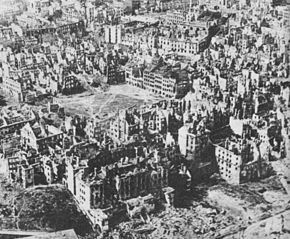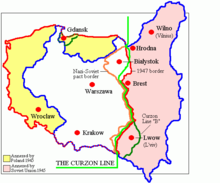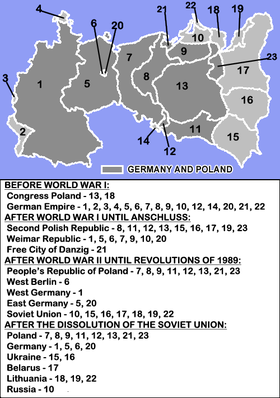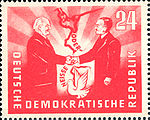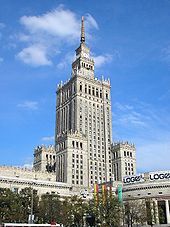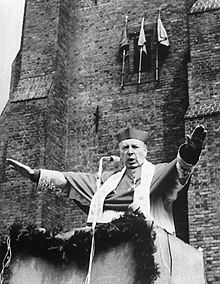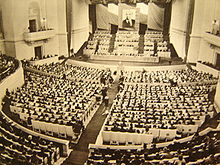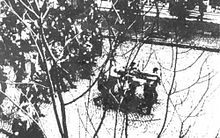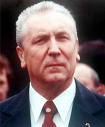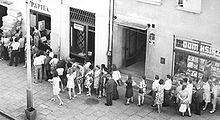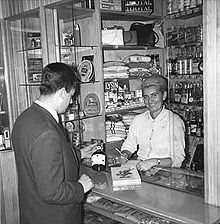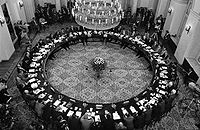
History of Poland (1945–1989)
Did you know...
This selection is made for schools by a children's charity read more. Click here to find out about child sponsorship.
The history of Poland from 1945 to 1989 spans the period of Soviet Communist dominance imposed after the end of World War II over the People's Republic of Poland. These years, while featuring many improvements in the standards of living in Poland, were marred by social unrest and economic depression.
Near the end of World War II, the advancing Soviet Red Army pushed out the Nazi German forces from occupied Poland. At the insistence of Joseph Stalin, the Yalta Conference sanctioned the formation of a new Polish provisional and pro-Communist coalition government in Moscow, which ignored the Polish government-in-exile based in London. This has been described as a Western betrayal of Poland on the part of Allied Powers to appease the Soviet leader, and avoid a direct conflict. The Potsdam Agreement of 1945 ratified the westerly shift of Polish borders and approved its new territory between the Oder-Neisse and Curzon lines. Poland, as a result of World War II, for the first time in history became an ethnically homogeneous nation state without prominent minorities due to destruction of indigenous Polish-Jewish population in the Holocaust, the flight and expulsion of Germans in the west, resettlement of Ukrainians in the east, and the repatriation of Poles from Kresy. The new communist government in Warsaw solidified its political power over the next two years, while the Communist Polish United Workers' Party (PZPR) under Bolesław Bierut gained firm control over the country, which would become part of the postwar Soviet sphere of influence in Eastern Europe. Following Stalin's death in 1953, a political "thaw" in Eastern Europe caused a more liberal faction of the Polish Communists of Władysław Gomułka to gain power. By the mid-1960s, Poland began experiencing increasing economic, as well as political, difficulties. In December 1970, a price hike led to a wave of strikes. The government introduced a new economic program based on large-scale borrowing from the West, which resulted in an immediate rise in living standards and expectations, but the program faltered because of the 1973 oil crisis. In the late 1970s the government of Edward Gierek was finally forced to raise prices, and this led to another wave of public protests.
This vicious cycle was finally interrupted by the 1978 election of Karol Wojtyła as Pope John Paul II, strengthening the opposition to Communism in Poland. In early August 1980, the wave of strikes led to the founding of the independent trade union " Solidarity" ( Polish Solidarność) by electrician Lech Wałęsa. The growing strength of the opposition led the government of Wojciech Jaruzelski to declare martial law in December 1981. However, with the reforms of Mikhail Gorbachev in the Soviet Union, increasing pressure from the West, and continuing unrest, the Communists were forced to negotiate with their opponents. The 1989 Round Table Talks led to Solidarity's participation in the elections of 1989; its candidates' striking victory sparked off a succession of peaceful transitions from Communist rule in Central and Eastern Europe. In 1990, Jaruzelski resigned as the President of the Republic of Poland and was succeeded by Wałęsa after the December 1990 elections.
Creation of the People's Republic of Poland (1944–1948)
Wartime devastation, border and population shifts
Poland suffered heavy losses during World War II. While in 1939 Poland had 35.1 million inhabitants, at the end of the war only 29.1 million remained within its borders. The first post-war census of 14 February 1946 showed 23.9 million due to migration. It is estimated that 6 million Polish citizens – nearly 21.4% of Poland's population died between 1939 and 1945; nevertheless, the number of ethnic Polish victims could have been smaller by as much as 50% due to multiethnic diversity of prewar Poland reflected in national censuses – according to 2009 statement by German-Polish reconciliation commission. The 3 million Jewish Polish victims are undisputed. Minorities in Poland were very significantly affected: before World War II, a third of Poland's population was composed of ethnic minorities; after the war, however, Poland's minorities were all but gone.
Poland, still a predominantly agricultural country compared to Western nations, suffered catastrophic damage to its infrastructure during the war, and lagged even further behind the West in industrial output in the War's aftermath. The losses in national resources and infrastructure amounted to over 30% of the pre-war potential. Poland's capital of Warsaw was among the most devastated cities, with over eighty percent destroyed in the aftermath of the Warsaw Uprising.
The implementation of the immense task of reconstructing the country was accompanied by the struggle of the new government to acquire a stable, centralized power base, further complicated by the mistrust a considerable part of the society held for the new regime and by disputes over Poland's postwar borders, which were not firmly established until mid-1945. In 1947 Soviet influence caused the Polish government to reject the American-sponsored Marshall Plan, and to join the Soviet Union-dominated Comecon in 1949. At the same time Soviet forces had engaged in plunder on the former eastern territories of Germany which were to be transferred to Poland, stripping it of valuable industrial equipment, infrastructure and factories and sending them to the Soviet Union.
After the Soviet annexation of the Kresy territories east of the Curzon line, about 2 million Poles were transferred and expelled from these areas into the new Western and Northern Territories east of the Oder-Neisse line, which the Soviets transferred from Germany to Poland after the Potsdam Agreement. Additional settlement with people from central parts of Poland brought up the number of Poles in what the government called the Regained Territories up to 5 million by 1950. The former German population of 10 million had fled or was expelled to post-war Germany by 1950. With the repatriation of Ukrainians from Poland to the Soviet Union and the 1947 Operation Vistula dispersing the remaining Ukrainian minority, and with most of the former Jewish minority exterminated by Nazi Germany during the Holocaust and many of the survivors emigrating to newly created Israel, Poland for the first time became an ethnically homogenous nation state. Warsaw and other ruined cities were cleared of rubble — mainly by hand — and rebuilt with great speed (one of the successes of the Three-Year Plan) at the expense of former German cities like Wrocław, which often provided the needed construction material.
The Regained Territories Exhibition ( Polish: Wystawa Ziem Odzyskanych), a propaganda exhibition celebrating "the restoration of the Recovered Territories to Poland" after the end of Second World War, was opened on 21 July 1948 by Bolesław Bierut and lasted for 100 days. About 2 million people have visited the exhibition and Iglica monument was built in front of the Centennial Hall in Wrocław.
Consolidation of Communist power (1945–1948)
Even before the Red Army entered Poland, the Soviet Union was pursuing a deliberate strategy to eliminate anti-Communist resistance forces to ensure that Poland would fall under its sphere of influence. In 1943, following the Katyn massacre, Stalin had severed relations with the Polish government-in-exile in London. However, to appease the United States and the United Kingdom, the Soviet Union agreed at the February 1945 Yalta Conference to form a coalition government composed of the communist Polish Workers' Party, members of the pro-Western Polish government in exile, and members of the Armia Krajowa ("Home Army") resistance movement, as well as to allow for free elections to be held.
With the beginning of the liberation of Polish territories and the failure of the Armia Krajowa's Operation Tempest in 1944, control over Polish territories passed from the occupying forces of Nazi Germany to the Red Army, and from the Red Army to the Polish Communists, who held the largest influence under the provisional government. Thus from its outset, the Yalta decision favored the Communists, who enjoyed the advantages of Soviet support for their plan of bringing Eastern Europe securely under its influence, as well as control over crucial ministries such as the security services.
The Prime Minister of the Polish government-in-exile, Stanisław Mikołajczyk, resigned his post in 1944 and, along with several other exiled Polish leaders, returned to Poland, where a Provisional Government (Rząd Tymczasowy Rzeczypospolitej Polskiej; RTTP), had been created by the Communist-controlled Polish Committee of National Liberation (Polski Komitet Wyzwolenia Narodowego; PKWN) in Lublin. This government was headed by Socialist Edward Osóbka-Morawski, but the Communists held a majority of key posts. Both of these governments were subordinate to the unelected, Communist-controlled parliament, the State National Council (Krajowa Rada Narodowa; KRN), and were not recognized by the increasingly isolated Polish government-in-exile, which had formed its own quasi-parliament, the Council of National Unity (Rada Jedności Narodowej; RJN).
The new Polish Provisional Government of National Unity (Tymczasowy Rząd Jedności Narodowej; TRJN) — as the Polish government was called until the elections of 1947 — was finally established on 28 June, with Mikołajczyk as Deputy Prime Minister. The Communist Party's principal rivals were the veterans of the Armia Krajowa movement, along with Mikołajczyk's Polish People's (Peasant) Party (Polskie Stronnictwo Ludowe; PSL), and the veterans of the Polish armies which had fought in the West. But at the same time, Soviet-oriented parties, backed by the Soviet Red Army (the Northern Group of Forces would be permanently stationed in Poland) and in control of the security forces, held most of the power, especially in the Polish Workers' Party (Polska Partia Robotnicza; PPR) under Władysław Gomułka and Bolesław Bierut.
In the years 1945-1947, about 500,000 Soviet soldiers were stationed in Poland. Between 1945 and 1948, some 150,000 Poles were imprisoned by the Soviet authorities. Many former Home Army members were apprehended and executed. The status of Soviet troops in Poland was not legalized until late 1956, when the Polish-Soviet declaration "On the legal status of Soviet forces temporarily stationed in Poland" was signed.
Rigged 1946 referendum and first elections of 1947
Stalin had promised at the Yalta Conference that free elections would be held in Poland. However, the Polish Communists, led by Gomułka and Bierut, were aware of the lack of support for their side among the general population. Because of this, in 1946 a national plebiscite, known as the "3 times YES" referendum (3 razy TAK; 3×TAK), was held first, instead of the parliamentary elections. The referendum comprised three fairly general, but politically charged questions about the Senate, national industries and western borders. It was meant to check the popularity of communist initiatives in Poland. Since most of the important parties at the time were leftist – and could have easily approved all three options – Mikołajczyk's PSL decided to ask its supporters to oppose one of them: the abolition of the senate. The Communists voted "3 times YES". The real results (reconstructed by PSL) showed that the communist side was met with little support; in Kraków where the actual ballots were counted, only 16% of the population voted in favour of their proposed Option One. However, the large-scale electoral fraud (vote rigging) and intimidation won the communists a majority in the carefully controlled poll, which led to the nationalization of industry, land reform, and a unicameral (not the bicameral) Sejm. Following the forged referendum, the Polish economy started to be nationalized.
The Communists consolidated power by gradually whittling away the rights of their non-Communist foes, particularly by suppressing the leading opposition party – Mikołajczyk's Polish People's Party (PSL). In some widely-publicized cases, their perceived enemies were being sentenced to death on trumped up charges — among them Witold Pilecki, the organizer of the Auschwitz resistance; and numerous leaders of Armia Krajowa and the Council of National Unity (see: the Trial of the Sixteen). Many resistance fighters were murdered extrajudicially, or forced to exile. The opposition members were also persecuted by administrative means. Although the ongoing persecution of the former anti-Nazi organizations by state security, forced thousands of partisans back into forests, the actions of the Ministry of Public Security of Poland (UB, Polish secret police), NKVD and Red Army steadily diminished their numbers.
By 1946, all rightist parties had been outlawed, and a new pro-government Front of National Unity was formed which included only the forerunner of the communist Polish United Workers' Party and its leftist allies. On January 19, 1947, the first parliamentary elections took place featuring PPR candidates and a token opposition from the Polish People's Party already powerless due to government control. Results were adjusted by Stalin himself to suit the Communists. Through rigged elections, the regime's candidates gained 417 of 434 seats in parliament ( Sejm), effectively ending the multi-party system in politics. Many opposition members, including Mikołajczyk (threatened with arrest), left the country. Western governments did not protest, which led free-spirited Poles to speak about a continued " Western betrayal" regarding Central Europe. In the same year, the new Legislative Sejm created the Small Constitution of 1947. Over the next two years, the Communists monopolizied their political power in Poland.
Additional force in Polish politics, the long-established Polish Socialist Party (Polska Partia Socjalistyczna, PPS – once led by Piłsudski), suffered a fatal split at this time, as the ruling Stalinists applied the salami tactics to dismember their opposition. Communist politicians supported a PPS faction led by Cyrankiewicz who personally visited Stalin with the idea of a party merger, securing his own place for the future. In 1948, the Communists and Cyrankiewicz's own faction joined ranks to form the Polish United Workers' Party (Polska Zjednoczona Partia Robotnicza; PZPR) in power for the next four decades. Poland became a de facto single-party state, and a satellite state of the Soviet Union. Only two other parties were allowed to exist legally, a small one for the farmers ( United People's Party) and a token one for the intelligentsia, called the Democratic Party (see also: political organization in Poland 1945-1989). A period of Sovietization and Stalinism started.
Stalinist era (1948–1956)
The repercussions of Yugoslavia's break with the Soviet Union reached Warsaw in 1948. As in other Eastern Bloc countries, there was a Soviet-style political purge of Communist officials, accused of "nationalist" or other "deviationist" tendencies in Poland. In September, Communist leader Władysław Gomułka, who opposed Stalin's direct control of the Polish party, was charged with "nationalistic tendency" and dismissed from his posts of First Secretary. He was arrested by the Ministry of Public Security and interrogated by both, Romkowski and Fejgin on Soviet orders. Gomułka escaped physical torture only as a former close associate of Stalin (according to some), or perhaps because Bierut and Berman desired only to save themselves. He was put under house arrest without typical show trial, and released unharmed a few years later, in 1954 or 1955. Bierut replaced him as party leader until his own sudden death.
The new government was controlled by Polish Communists who had spent the war in the Soviet Union, aided by the Ministry of Public Security, and the Soviet "advisers" who were placed in every arm of the government as guarantee of the pro-Soviet policy of the state. The most important of them was Konstantin Rokossovsky (Konstanty Rokossowski in Polish), the Defense Minister from 1949 to 1956, former Marshal in the Soviet Armed Forces, backed by a slew of well-trained Russian Commissars in control of Polish state security. The Soviet-style secret police and Urząd Bezpieczeństwa (UB) grew to around 32,000 agents as of 1953. There was one UB agent for every 800 Polish citizens; never again, in the history of Communism in Poland, were the special services so large in numbers. The MBP ministry was also in charge of Internal Security Corps, the Civil Militia ( MO), Border guard, prison staff (Straż Więzienna); and paramilitary police ORMO used for special actions (with 125,000 members). For many years, the public prosecutors and judges as well as functionaries of MBP, Służba Bezpieczeństwa and GZI WP military police engaged in acts recognized by international law as crimes against humanity, and crimes against peace, such as the torture and execution of seven members of the 4th Headquarters of anti-Communist organization Wolność i Niezawisłość (WiN) in the Mokotów Prison in Warsaw after the official amnesty and their voluntary disclosure. All executed members of WiN took active part in anti-Nazi resistance during World War II. The postwar Polish Army, intelligence and police were full of Soviet NKVD officers who stationed in Poland with the Northern Group of Forces until 1956.
Mass arrests continued during the early 50s – in October 1950, 5,000 people were arrested in one night, in so called "Operation K"; in 1952 over 21,000 people were arrested . According to official data, there were 49,500 political prisoners in the second half of 1952.
Nationalization and centrally planned economy
The last Polish–Soviet territorial exchange took place in 1951. Some 480 km2 (185 sq mi) of land along the border were swapped between the People's Republic of Poland and the Soviet Union. The adjustment was made to the decisive economic benefit of the Russians due to rich deposits of coal given up by Poland. Within eight years following the exchange, the Soviets built four large coal-mines there, producing 15 million tons of coal annually.
The government, headed by Cyrankiewicz and Marxist economist Hilary Minc embarked on a sweeping program of economic reform and national reconstruction. The Stalinist turn, that led to the ascension of Bierut meant that Poland would now be brought into line with the Soviet model of a " people's republic" and a centrally planned socialist economy, in place of the façade of democracy and market economy which the regime had maintained until 1948. Fully Soviet-style centralized planning begun in 1950 with the Six-Year Plan. The plan focused on rapid development of heavy industry and (eventually futile) collectivization of agriculture. The land seized from prewar large landowners was redistributed to the poorer peasants, but subsequent attempts at taking the land from farmers met wide resentment. In what became known as the battle for trade, the private trade and industry were nationalized. Within few years the private shopkeeper disappeared from Poland. The regime embarked on the campaign of collectivization (as seen in the creation of Państwowe Gospodarstwo Rolne), although the pace for this change was slower than in other satellites. Poland remained the only Soviet bloc country where individual peasants would continue to dominate agriculture.
In 1948 the United States announced the Marshall plan initiative to help rebuild Europe and thus gain more political power in postwar conditions. After initially welcoming the idea of Poland's participation in the plan, the government declined the offer of help under pressure from Moscow. Also, following the uprising of 1953 in East Germany, Poland was forced by the Soviet Union to give up its claims to compensation from Germany, which as a result paid no significant compensation for war damages, either to the Polish state or to Polish citizens. Although Poland received compensation in the form of the territories and property left behind by the German population of the annexed western territories, it is disputed whether they were enough compensation for the loss of Kresy territories. This marked the beginning of the wealth gap, which would increase in years to come, as the Western market economies grew much more quickly than the centrally planned socialist economies of Eastern Europe.
Stalinist period of relative normality
The constitution of 1952 guaranteed universal free health care. In the early 1950s, the Stalinist regime also carried out major changes to the education system. The Communist program of free and compulsory school education for all, and the establishment of new free universities, received much support. The Communists, however, screened out what facts and interpretations were to be taught; history as well as other sciences had to follow Marxist views approved by ideological censorship. At the same time, between 1951–1953, a large number of prewar professors who were perceived as "reactionary" by the new regime, was dismissed from universities. The government control over art and artists deepened. The Soviet-style Socialist Realism became the only formula accepted by the authorities after 1949. Most works of art and literature presented to the public had to be in line with the voice of the Party and thus present its own propaganda (see also: Socialist realism in Poland).
The reforms, while reasonably controversial, were greeted with relief by a significant faction of the population. After the Second World War many people were willing to accept Communist rule in exchange for the restoration of relatively normal life; tens of thousands joined the communist party and actively supported the regime. Nonetheless a latent popular discontent remained present. Many Poles adopted an attitude that might be called "resigned cooperation". Others, like the remnants of the Armia Krajowa, and Narodowe Siły Zbrojne and Wolność i Niezawisłość, known as the cursed soldiers, actively opposed the Communists, hoping that a possible World War III would liberate Poland. Although most had surrendered during the amnesty of 1947, the brutal repressions by the secret police led many of them back into the forests, where a few continued to fight well into the 1950s.
The Communists further alienated many Poles by persecuting the Catholic Church. The Stowarzyszenie PAX ("PAX Association") created in 1947 worked to undermine grassroot support from Roman Catholicism and attempted to create a Communism-friendly Church. In 1953 the Cardinal Primate of Poland, Stefan Wyszyński, was placed under house arrest, although before that he had been willing to make compromises with the government. In the early 1950s, the war against religion by secret police led to the arrest and torture of hundreds of Polish religious personalities, culminating in the Stalinist show trial of the Kraków Curia. The Office of the Council of Ministers (Urząd Rady Ministrów) produced a list of government-approved Bishops. See also: Polish anti-religious campaign (1945–1990).
The new Polish Constitution of 1952 officially established Poland as a People's Republic, ruled by the Polish United Workers' Party, which since the absorption of the left wing of the Socialist Party in 1948 had been the Communist Party's official name. The post of President of Poland was abolished, and Bierut, the First Secretary of the Communist Party, became the effective leader of Poland.
Stalin had died in 1953. Between 1953 and 1958 Nikita Khrushchev outmaneuvered his rivals and achieved power in the Soviet Union. In March 1956 Khrushchev denounced Stalin's cult of personality at the 20th Congress of the Soviet Communist Party. The de-Stalinization of official Soviet ideology left Poland's Stalinist hard-liners in a difficult position. In the same month as Khrushchev's speech, as unrest and desire for reform and change among both intellectuals and workers was beginning to surface throughout the Eastern Bloc, the death of the hardline Bierut in March 1956 exacerbated an existing split in the PZPR. Bierut was succeeded by Edward Ochab as First Secretary of the PZPR, and by Cyrankiewicz, brought back as Prime Minister.
Gomułka's road to Socialism (1956–1970)
Polish October and the process of de-Stalinization
In June 1956, workers in the industrial city of Poznań went on strike caused by the appaling working conditions and wage fraud. Demonstrations by factory workers turned into a huge city-wide protest. Soon, 16 tanks, 2 armoured personnel carriers and 30 anti-riot vehicles rolled in on Rokossowsky's orders. Some 53–80 people were killed and over 300 injured in a shooting rampage when the 10th and 19th Armoured Divisions, reinforced by the 2nd Armoured Corps and the 4th Infantry Division entered the scene. Cyrankiewicz tried to frighten the rioters. In his widely publicized speech, he threatened that: "any provocateur or lunatic who will dare raise his hand against the people's rule may be sure that this hand will be chopped off."
Shaken to its foundations, the 7th Plenum of the Central Committee held in July 1956 split into two informal factions, the "ethno-nationalist" Natolin and the "reformist" Puławy faction named after the locations where they held their meetings: the Palace of Natolin near Warsaw, and Puławska Street in Warsaw. Natolin consisted largely of communist officials from the army and state security including Moczar, Kliszko and Nowak, who advocated the removal of Stalin's Jewish protégés from the system, and publicly gave Gomułka their backing. Puławy faction included Jewish Communists from the security apparatus who in large part spent the war in the USSR; as well as disillusioned opportunists, and members of the old Communist intelligentsia. Both factions supported the Sovietization of Poland with slightly different aim, but the staunch Stalinists lacked the support of Khrushchev who flew in with a high-level delegation, and the regime turned to conciliation: it announced wage rises and other reforms. Voices began to be raised in the Party and among the intellectuals calling for wider reforms of the Stalinist system.
Realizing the need for new leadership, in what became known as the Polish October, the 8th Plenum chose Władysław Gomułka – released from house arrest – as the new First Secretary of PZPR. He was elected on October 19, 1956. Gomułka, pledging to dismantle Stalinism, convinced the Soviet Union that he would not allow its influence on Eastern Europe to diminish. Even so, Poland's relations with Kremlin were not nearly as strained as Yugoslavia's, and the end of Soviet influence in Poland was nowhere in sight; after all, on 14 May 1955 the Warsaw Pact was signed in the Polish capital, to counteract the establishment of NATO.
The 20th Congress launched a process of partial democratisation of Polish political as well as economic life. The number of security agents was cut by 22%, and 9,000 socialist and populist politicians were released from prison on top of some 34,644 detainees across the entire country. Hardline Stalinists, such as Berman and Romkowski were removed from power, and many Soviet officers serving in the Polish Armed Forces were dismissed, but almost no one was put on trial for the repressions of the Bierut period with the above notable exceptions. The Puławy faction argued that mass trials of Stalinist officials, many of them Jewish, would incite animosity toward the Jews. Konstantin Rokossovsky and other Soviet advisors were sent home, and Polish Communism took on a more independent orientation. However, Gomułka knew that the Soviets would never allow Poland to leave the Warsaw Pact because of Poland's strategic position between the Soviet Union and Germany. He agreed that Soviet troops could remain in Poland, and that no overt anti-Soviet outbursts would be allowed. In this way, Poland avoided the risk of Soviet armed intervention, the kind that crushed the 1956 Hungarian Revolution in October.
There were also repeated attempts by some Polish academics and philosophers, many related to the prewar Lwow-Warsaw School - such as Leszek Kołakowski, Stanisław Ossowski and Adam Schaff - to develop a specific form of Polish Marxism. Their attempts to create a bridge between Poland's history and Soviet Marxist ideology were mildly successful, although stifled due to the regime's unwillingness to risk the wrath of the Soviet Union for going too far from the Soviet party line.
Scaling back of campaign promises
Poland welcomed Gomułka's rise to power with relief. Many Poles still rejected Communism, but the realities of Soviet dominance dictated that Poland could not shake-off Communist rule. Gomułka promised an end to police terror, greater intellectual and religious freedom, higher wages and the reversal of collectivization, and to a some degree he fulfilled these promises.
Poland under Gomułka's rule was generally described as one of the more "liberal" Communist regimes. In 1958–59 Poland devised the "Iron Triangle plan" of favored relations with East Germany and Czechoslovakia. Meanwhile, in August 1961 the new Berlin Wall cemented the division of Europe. Under Gomułka, Poles could still go to prison for writing political satire about the Party leader, as Janusz Szpotański did, or for publishing a book abroad. A future dissident, Jacek Kuroń, was imprisoned for writing an "open letter" to other Party members. In the following years, the regime became steadily less liberal and more repressive. Gomułka's popularity declined as his initial vision lost its impetus.
After the first wave of reform, Gomułka's regime started to move back on their promises. The Communist control over the mass media and universities, was gradually tightened, and many of the younger and more reformist members of the Party forced-out. The reform-promising Gomułka of 1956 turned into the authoritarian Gomułka of the 1960s. Although Poland enjoyed a period of relative stability in the next decade, the idealism of the " Polish October" faded away.
By the mid-1960s, Poland was starting to experience economic, as well as political difficulties. Similar to other Communist regimes, Poland was spending too much on heavy industry, armaments and prestige projects, and too little on consumer production. The failure of Soviet-style collectivization returned the land to the peasants, but most of their farms were too small to be prosperous, so productivity in agriculture remained low. Economic relations with West Germany were frozen due to East German interference and resistance to economic integration (CEMA). Gomułka chose to ignore the signs of economic depression. His autocratic methods prevented the major changes required to halt a downward economic spiral.
The 1962 Szczecin military parade led to a road traffic accident in which a tank of the Polish People's Army crushed bystanders, killing seven children and injuring many more. The resultant panic in the crowd led to further injuries in the rush to escape. The incident was covered up for many years by the Polish communist authorities.
1968-1970 events in Poland
By the 1960s, other government officials had begun to plot against Gomułka. His security chief, Mieczysław Moczar, a wartime Communist partisan commander, formed a new faction, "the Partisans", based on principles of Communist nationalism and anti- inteligencja and anti-Jewish sentiment. The Party boss in Upper Silesia, Edward Gierek, who unlike most of the Communist leaders was a genuine product of the working class, also emerged as a possible alternative leader.
In March 1968 student demonstrations at Warsaw University broke out when the government banned the performance of a play by Adam Mickiewicz ( Dziady, written in 1824) at the Polish Theatre in Warsaw, because it contained "anti-Soviet references". In what became known as the March 1968 events Moczar used this affair as a pretext to launch an anti-intellectual and anti-Semitic press campaign (although the expression "anti-Zionist" was the one officially used) whose real goal was to weaken the pro-reform liberal faction. Approximately 20,000 Jews lost their jobs and had to emigrate. The success of the ORMO attack on university students simultaneously in several major cities – in the wake of growing citizen discontent (see Polish 1970 protests) – prompted the Ministry to began massive expansion of its rank-and-file. By 1979, ORMO reached over 450,000 members.
The communist government reacted in several ways to the March events. One was an official approval for demonstrating Polish national feelings, including the scaling down of official criticism of the prewar Polish regime, and of Poles who had fought in the anti-Communist wartime partisan movement, the Armia Krajowa. The second was the complete alienation of the regime from the leftist intelligentsia, who were disgusted at the official promotion of anti-Semitism. Many Polish intellectuals opposed the campaign, some openly, and Moczar's security apparatus became as hated as Berman's had been. The third was the founding by Polish Emigrants to the West of organizations that encouraged opposition within Poland. The campaign damaged Poland's reputation abroad, particularly in the United States.
Two things saved Gomułka's regime at this point. First, the Soviet Union, now led by Leonid Brezhnev, made it clear that it would not tolerate political upheaval in Poland at a time when it was trying to deal with the crisis in Czechoslovakia. In particular, the Soviets made it clear that they would not allow Moczar, whom they suspected of anti-Soviet nationalism, to be leader of Poland. Second, the workers refused to rise up against the regime, partly because they distrusted the intellectual leadership of the protest movement, and partly because Gomułka placated them with higher wages. The Catholic Church, while protesting against police violence against demonstrating students, was also not willing to support a direct confrontation with the regime.
Food riots and the ousting of Gomułka
In August 1968 the Polish People's Army took part in the invasion of Czechoslovakia. Some Polish intellectuals protested, and Ryszard Siwiec burned himself alive during the official national holiday celebrations. Polish participation in crushing Czech liberal communism (or socialism with a human face, as it was called then) further alienated Gomułka from his former liberal supporters. However, in 1970 Gomułka won a political victory when he gained West German recognition of the Oder-Neisse line. The German Chancellor, Willy Brandt who signed the agreement, also asked on his knees for forgiveness for the crimes of the Nazis ( Warschauer Kniefall). His gesture was understood in Poland as being addressed to all Poles, although it was actually made at the site of the Warsaw Ghetto and was thus directed primarily toward the Jews. Notably, five years earlier, the Polish church had already issued its famous Letter of Reconciliation of the Polish Bishops to the German Bishops, although criticized by the Polish government.
Gomułka's temporary political success marked by the new agreement with West Germany, could not mask the economic crisis into which Poland was drifting, exacerbated by Soviet demands for more military spending. Although the system of fixed, artificially low food prices kept urban discontent under control, it caused further economic stagnation. This situation was unsustainable, and on December 12, 1970 (just before Christmas), the regime suddenly announced massive increases in the prices of basic foodstuffs – the main source of hard currency in foreign exchange. It is possible, that the price rises were imposed on Gomułka by his own enemies in the Party, who planned to maneuver him out of power. The new measures were incomprehensible to many urban workers, and their provocative timing led to Gomułka's ultimate fall from power.
On December 14–19, 1970 mass demonstrations against the price rises broke out in the northern coastal cities of Gdańsk, Gdynia, Elbląg and Szczecin. Gomułka's right-hand man, Zenon Kliszko, made matters worse by ordering the army to fire on protesting workers. Another communist leader, Stanisław Kociołek, appealed to the workers to return to work just before signing off on the shoot-to-kill order received from the Central Committee. In Gdynia, the soldiers were instructed to prevent protesters from returning to factory buildings. They fired into a crowd of workers emerging from commuter trains; hundreds of people were killed. The protest movement spread to other cities, leading to more strikes and causing angry workers to occupy many factories (see also the 1971 Łódź strikes). The general strike across Poland was scheduled for December 21, 1970.
The Party leadership met in Warsaw and decided that a full-scale working-class revolt was inevitable unless drastic steps were taken. With the consent of Brezhnev in Moscow, Gomułka, Kliszko and other leaders were forced to resign. Since Moscow would not accept the appointment of Moczar, Edward Gierek was drafted as the new First Secretary of the PZPR. Prices were lowered, wage increases were announced, and sweeping economic and political changes were promised. Gierek went to Gdańsk and met the workers personally, apologizing for the mistakes of the past, and saying that as a worker himself, he would now govern Poland for the people.
Gierek decade (1970–1980)
Gierek, like Gomułka in 1956, came to power on a raft of promises that everything would be different from now on; that wages would rise, prices would remain stable, there would be freedom of speech, and those responsible for the violence at Gdynia and elsewhere would be punished. Although Poles were much more sceptical than they had been in 1956, Gierek was believed to be an honest and well-intentioned man, and his promises bought him some time. He used this time to create a new economic program, one based on large-scale borrowing from banks in the West — mainly from the United States and West Germany — to buy technology that would upgrade Poland's production of export goods. This massive borrowing, estimated to have totaled US$10 billion, was used to re-equip and modernize Polish industry, and to import consumer goods to give the workers more incentive to work.
For the next four years, Poland enjoyed rapidly rising living standards and an apparently stable economy. Real wages rose 40% between 1971 and 1975, and for the first time many Poles could afford to buy cars, televisions and other consumer goods. Poles living abroad, veterans of the Armia Krajowa and the Polish Armed Forces in the West, were invited to return and to invest their money in Poland, which many did. The peasants were subsidized to grow more food. Poles were able to travel — mainly to West Germany, Sweden and Italy — with little difficulty. There was also some cultural and political relaxation. As long as the "leading role of the Party" and the Soviet "alliance" were not criticized, there was a limited freedom of speech. With the workers and peasants reasonably happy, the regime knew that a few grumbling intellectuals could pose no challenge.
"Consumer Communism", based on present global economic conditions, raised Polish living standards and expectations, but the program faltered suddenly in the early 1970s because of worldwide recession and increased oil prices. The effects of the world oil shock following the 1973 Arab-Israeli War produced an inflationary surge followed by a recession in the West, which resulted in a sharp increase in the price of imported consumer goods, coupled with a decline in demand for Polish exports, particularly coal. Poland's foreign debt rose from US$100 million in 1971 to US$6 billion in 1975, and continued to rise rapidly. This made it increasingly difficult for Poland to continue borrowing from the West. Again, consumer goods began to disappear from Polish shops. The new factories built by Gierek's regime also proved to be largely ineffective and mismanaged, often ignoring basics of market demand and cost effectiveness.
In 1975, Poland and almost all other European countries became signatories of the Helsinki Accords and a member of Organization for Security and Co-operation in Europe (OSCE), the creation of which marked the high point of the period of " détente" between the Soviet Union and the United States. Despite the regime's claims that the freedoms mentioned in the agreement would be implemented in Poland, there was little change. However, Poles were gradually becoming more aware of the rights they were being denied.
Economics of chronic shortages
As the government became increasingly unable to borrow money from abroad, it had no alternative but to raise prices, particularly for basic foodstuffs. The government had been so afraid of a repeat of the 1970 worker rebellion that it had kept prices frozen at the 1970 levels rather than allowing them to rise gradually. Then, in June 1976, under pressure from Western creditors, the government again introduced price increases: butter by 33%, meat by 70%, and sugar by 100%. The result was an immediate nationwide wave of strikes, with violent demonstrations and looting at Płock and Radom. Gierek backed down at once, dismissing Prime Minister Piotr Jaroszewicz and repealing the price rises. This left the government looking both economically foolish and politically weak, a very dangerous combination.
The 1976 disturbances and the subsequent arrests and dismissals of worker militants brought the workers and the intellectual opposition to the regime back into contact. A group of intellectuals led by Jacek Kuroń and Adam Michnik founded the Committee for the Defence of the Workers (Komitet Obrony Robotników; KOR). The aim of the KOR was at first simply to assist the worker victims of the 1976 repression, but it inevitably became a political resistance group. It marked an important development: the intellectual dissidents accepting the leadership of the working class in opposing the regime. These events brought many more Polish intellectuals into active opposition of the Polish government. The complete failure of the Gierek regime, both economically and politically, led many of them to join or rejoin the opposition. During this period, new opposition groups were formed, such as the Confederation of Independent Poland (KPN), Free Trade Unions of the Coast (WZW) and the Movement for Defense of Human and Civic Rights (ROPCiO), which tried to resist the regime by denouncing it for violating Polish laws and the Polish constitution.
For the rest of the 1970s, resistance to the regime grew, as trade unions, student groups, clandestine newspapers and publishers, ROPCiO and KOR, imported books and newspapers, and even a " flying university". The regime practiced wide spread police surveillance, beatings, torture, firings, and other forms of repression against the democracy movement. Gierek simultaneously tried to buy off dissatisfied workers and keep the Soviet Union convinced that Poland was a loyal ally. But the Soviet alliance was at the heart of Gierek's problems: following Brezhnev Doctrine and because of Poland's strategic position between the Soviet Union and Germany, the Soviets would never allow Poland to drift out of its orbit, as Yugoslavia and Romania had by this time done. Nor would they allow any fundamental economic reform that would endanger the "socialist system".
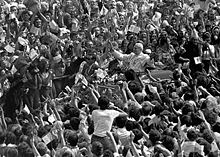
Polish Pope John Paul II
On 16 October 1978, Poland experienced what many Poles literally believed to be a miracle. The Archbishop of Kraków, Karol Wojtyła, was elected Pope at the Vatican, taking the name John Paul II. The election of a Polish Pope had an electrifying effect, on what was by the 1970s one of the last idiosyncratically Catholic countries in Europe. When John Paul toured Poland in June 1979, half a million people came to welcome him in Warsaw, and in the next eight days, about ten million Poles attended at least one of his numerous outdoor masses. Overnight, John Paul became the most important person in Poland, leaving the regime not so much opposed as ignored. However, John Paul did not call for rebellion; instead, he encouraged the creation of an "alternative Poland" of social institutions independent of the government, so that when the next crisis came, the nation would present a united front.
By 1980, the Communist leadership was completely trapped by Poland's economic and political dilemma. The regime had no means of legitimizing itself, since it knew that the PZPR would never win a free election. It had no choice but to make another attempt to raise consumer prices to realistic levels, but it knew that to do so would certainly spark another worker rebellion, much better-organized than the 1970 or 1976 outbreaks. Western bankers had loaned over $500 million to the government of Poland, and at a meeting at the Bank Handlowy in Warsaw on 1 July 1980, made it clear that low prices of consumer goods could no longer be subsidized by the state. The government gave in and announced a system of gradual but continuous price rises, particularly for meat. A wave of strikes and factory occupations began at once, with the biggest ones taking place in Lublin - see Lublin 1980 strikes, coordinated from KOR's headquarters in Warsaw. From the end of World War II until 1978, the US government loaned and gave the Communist regime in Poland $677 million. In 1979, it granted the Communist regime in Poland an additional $500 million in loans and loan guarantees.
The leadership made little effort to intervene. By this time, the Polish Communists had lost the Stalinist zealotry of the 1940s; they had grown corrupt and cynical during the Gierek years, and had no stomach for bloodshed. The country waited to see what would happen. In early August, the strike wave reached the politically sensitive Baltic coast, with a strike at the Lenin Shipyards in Gdańsk. Among the leaders of this strike was electrician Lech Wałęsa, who would soon become a figure of international importance. The strike wave spread along the coast, closing the ports and bringing the economy to a halt. With the assistance of the activists from KOR and the support of many intellectuals, the workers occupying the various factories, mines and shipyards across Poland came together (see also Jastrzębie-Zdrój 1980 strikes).
The leadership was now faced with a choice between repression on a massive scale and an agreement that would give the workers everything they wanted, while preserving the outward shell of Communist rule. They chose the latter, and on 31 August, Wałęsa signed the Gdańsk Agreement with Mieczysław Jagielski, a member of the PZPR Politburo. The Agreement acknowledged the right of Poles to associate in free trade unions, abolished censorship, abolished weekend work, increased the minimum wage, increased and extended welfare and pensions, and abolished Party supervision of industrial enterprises. Party rule was significantly weakened in what was regarded as a first step toward dismantling the Party's monopoly of power, but nonetheless preserved, as it was recognized as necessary to prevent Soviet intervention. The fact that all these economic concessions were completely unaffordable escaped attention in the wave of national euphoria that swept the country. The period that started afterwards is often called the first part of the "Polish carnival" - with the second one taking place in the second half of 1980s. Apart from Gdańsk Agreement, similar documents were signed in Szczecin ( Szczecin Agreement), Jastrzębie-Zdrój, and Katowice Steelworks.
End of Communist rule (1980–1990)
The Gdańsk Agreement, an aftermath of the August 1980 labor strike, was an important milestone. It led to the formation of an independent trade union, " Solidarity" (Polish Solidarność), founded in September 1980 and originally led by Lech Wałęsa. In the 1980s, it helped form a broad anti-Communist social movement, with members ranging from people associated with the Roman Catholic Church to anti-Communist leftists. The union was backed by a group of intellectual dissidents, the KOR, and adhered to a policy of nonviolent resistance. In time, Solidarity became a major Polish political force in opposition to the Communists.
The ideas of the Solidarity movement spread rapidly throughout Poland; new unions were formed and joined the federation. The Solidarity program, although concerned chiefly with trade union matters, was universally regarded as the first step towards dismantling the Communists' dominance over social institutions, professional organizations and community associations. By the end of 1981, Solidarity had nine million members — a quarter of Poland's population, and three times as many members as the PUWP had. Using strikes and other tactics, the union sought to block government initiatives. Apart from workers, both individual farmers and students created their own independent organizations - Rural Solidarity, and Independent Students' Union.
In September 1980, the increasingly frail Gierek was removed from office and replaced as Party leader by Stanisław Kania. Kania made the same sort of promises that Gomułka and Gierek made when they had come to power. But whatever goodwill the new leader gained by these promises was even shorter lived than it had been in 1956 and 1971, because there was no way that the regime could have kept the promises it had made at Gdańsk, even if it wanted to. The regime was still trapped by the conflict between economic necessity and political instability. It could not revive the economy without abandoning state control of prices, but it could not do this without triggering another general strike. Nor could it gain the support of the population through political reform, because of the threat of Soviet intervention. GNP fell in 1979 by 2%, in 1980 by 8% and in 1981 by 15–20%. Public corruption had become endemic and housing shortages and food rationing were just three of many factors contributing to the growing social unrest, which was expressed, among others, in hunger demonstrations, taking place across the country in the summer of 1981, and a massive warning strike, in the spring of 1981. Another example of mass protests which took place at that time was the 1981 General strike in Bielsko-Biała.
Imposition of martial law
On 13 December 1981, claiming that the country was on the verge of economic and civil breakdown, and alleging a danger of Soviet intervention (whether this danger was real, at that particular moment, is disputed by historians, see Soviet reaction to the Polish Crisis of 1980-1981), Wojciech Jaruzelski, who had become the Party's national secretary and prime minister that year, began a crack-down on Solidarity; declaring martial law, suspending the Union, and temporarily imprisoning most of its leaders. Polish state Militia ( Milicja Obywatelska) and paramilitary riot police (Zmotoryzowane Odwody Milicji Obywatelskiej; ZOMO) suppressed the strike action and demonstrations in a series of violent attacks such as the massacre of striking miners in the Wujek Coal Mine (9 killed). The government banned Solidarity officially on 8 October 1982, after a series of street demonstrations against military rule, which reached its climax on August 31, 1982. Martial law was formally lifted in July 1983, though many heightened controls on civil liberties and political life, as well as food rationing, remained in place throughout the mid-to-late 1980s.
During the chaotic Solidarity years and the imposition of martial law, Poland entered a decade of economic crisis, officially acknowledged as such even by the regime. Work on most of the major investment projects that had begun in the 1970s was stopped, resulting in landmarks such as the Szkieletor skyscraper in Kraków. Rationing and queuing became a way of life, with ration cards (Kartki) necessary to buy even such basic consumer staples as milk and sugar. Access to Western luxury goods became even more restricted, as Western governments applied economic sanctions to express their dissatisfaction with the government repression of the opposition, while at the same time the government had to use most of the foreign currency it could obtain to pay the crushing rates on its foreign debt which reached US$23 billion by 1980. In response to this situation, the government, which controlled all official foreign trade, continued to maintain a highly artificial exchange rate with Western currencies. The exchange rate worsened distortions in the economy at all levels, resulting in a growing black market and the development of a shortage economy.
The Communist government unsuccessfully tried various expedients to improve the performance of the economy. To gather foreign currency, the government established a chain of state-run Pewex stores in all Polish cities where goods could only be bought with Western currency, as well as issued its own ersatz U.S. currency (bony). During the era hundreds of thousands of Poles emigrated looking for jobs and prosperity abroad. The government was increasingly forced to carry out small-scale reforms, allowing more small-scale private enterprises to function and departing further and further from the 'socialist' model of economy.
Facing the inevitable
The government slowly but inevitably started to accept the idea that some kind of deal with the opposition would be necessary. The constant state of economic and societal crisis meant that, after the shock of martial law had faded, people on all levels again began to organize against the regime. "Solidarity" gained more support and power, though it never approached the levels of membership it enjoyed in the 1980–1981 period. At the same time, the dominance of the Communist Party further eroded as it lost many of its members, a number of whom had been outraged by the imposition of martial law. Throughout the mid-1980s, Solidarity persisted solely as an underground organization, supported by a wide range of international supporters, from the Roman Catholic Church to the Central Intelligence Agency. Starting from 1986, other opposition structures such as Fighting Solidarity, Federation of Fighting Youth, and Orange Alternative "dwarf" movement founded by "Major" Waldemar Fydrych began organizing street protests in form of colorful happenings that assembled thousands of participants and broke the fear barrier which was paralysing the population since the Martial Law. By the late 1980s, Solidarity was strong enough to frustrate Jaruzelski's attempts at reform, including a failed attempt to gain a popular mandate for changes in a national referendum held in November, 1987, and nationwide strikes in May and August 1988 were one of the factors that forced the government to open a dialogue with Solidarity on 31 August 1988.
The perestroika and glasnost policies of the Soviet Union's new leader, Mikhail Gorbachev, were another factor in stimulating political reform in Poland. In particular, Gorbachev essentially repudiated the Brezhnev Doctrine, which had stipulated that attempts by its Eastern European satellite states to abandon Communism would be countered by the Soviet Union with force. This change in Soviet policy, along with the hardline stance of US President Ronald Reagan against Soviet military incursions, removed the specter of a possible Soviet invasion in response to any wide-ranging reforms, and hence eliminated the key argument employed by the Communists as a justification for maintaining Communism in Poland.
By the close of the 10th plenary session on 18 January 1989, the Communist Party had decided to approach leaders of Solidarity for formal talks. From 6 February to 4 April, 94 sessions of talks between 13 working groups, which became known as the " Round Table Talks" (Polish: Rozmowy Okrągłego Stołu) radically altered the structure of the Polish government and society. The talks resulted in an agreement to vest political power in a newly created bicameral legislature, and in a president who would be the chief executive.
On 4 April 1989, Solidarity was again legalized and allowed to participate in semi-free elections on 4 June 1989. This election was not completely free, with restrictions designed to keep the Communists in power, since only one third of the seats in the key lower chamber of parliament would be open to Solidarity candidates. The other two thirds were to be reserved for candidates from the Communist Party and its two allied, completely subservient parties. The Communists thought of the election as a way to keep power while gaining some legitimacy to carry out reforms. Many critics from the opposition believed that by accepting the rigged election Solidarity had bowed to government pressure, guaranteeing the Communists domination in Poland into the 1990s.
When the results were released, a political earthquake followed. The victory of Solidarity surpassed all predictions. Solidarity candidates captured all the seats they were allowed to compete for in the Sejm, while in the Senate they captured 99 out of the 100 available seats (the other seat went to an independent, who later switched to Solidarity). At the same time, many prominent Communist candidates failed to gain even the minimum number of votes required to capture the seats that were reserved for them. With the election results, the Communists suffered a catastrophic blow to their legitimacy.
The next few months were spent on political maneuvering. The prestige of the Communists fell so low that, even the two puppet parties allied with them decided to break away and adopt independent courses. The new Communist Prime Minister, general Czesław Kiszczak, who was appointed on 2 August 1989, failed to gain enough support in the Sejm to form a government, and resigned on 19 August 1989. He was the last Communist head of government in Poland. Although Jaruzelski tried to persuade Solidarity to join the Communists in a "grand coalition", Wałęsa refused. By August 1989, it was clear that a new Prime Minister would have to be chosen from among the Solidarity nominees. Jaruzelski resigned as general secretary of the Communist Party on 29 July 1989, forced to come to terms with the prospect of new government being formed by political opposition. Increasingly nervous Communists, who still had administrative control over the country, were temporarily appeased by a compromise in which Solidarity allowed General Jaruzelski to remain head of state. Jaruzelski won by just one vote in the National Assembly presidential election of 19 July 1989 even though his name was the only one on the Communist ballot. Essentially, he won through abstention by a sufficient number of Solidarity MPs. Wojciech Jaruzelski became President, but Solidarity elected representative Tadeusz Mazowiecki assumed the office of Prime Minister. He was appointed on 24 August 1989. The new non-Communist government, the first of its kind in Communist Europe, was sworn into office on 13 September 1989. It immediately adopted radical economic policies, proposed by Leszek Balcerowicz, which transformed Poland into a functioning market economy over the course of the next year.
The striking electoral victory of the Solidarity candidates in these limited elections, and the subsequent formation of the first non-Communist government in the region in decades, encouraged many similar peaceful transitions from Communist Party rule in Central and Eastern Europe in the second half of 1989.
In 1990, Jaruzelski resigned as Poland's president and was succeeded by Wałęsa, who won the 1990 presidential elections. Wałęsa's inauguration as president in December, 1990 is thought by many to be the formal end of the Communist People's Republic of Poland and the beginning of the modern Republic of Poland. The communist Polish United Workers' Party dissolved itself in 1990, and transformed into Social Democracy of the Republic of Poland. The Warsaw Pact was dissolved in the summer of 1991 and the Soviet troops would leave Poland by 1993. On 27 October 1991 the first entirely free Polish parliamentary elections since the 1920s took place. This completed Poland's transition from Communist Party rule to a Western-style liberal democratic political system.

